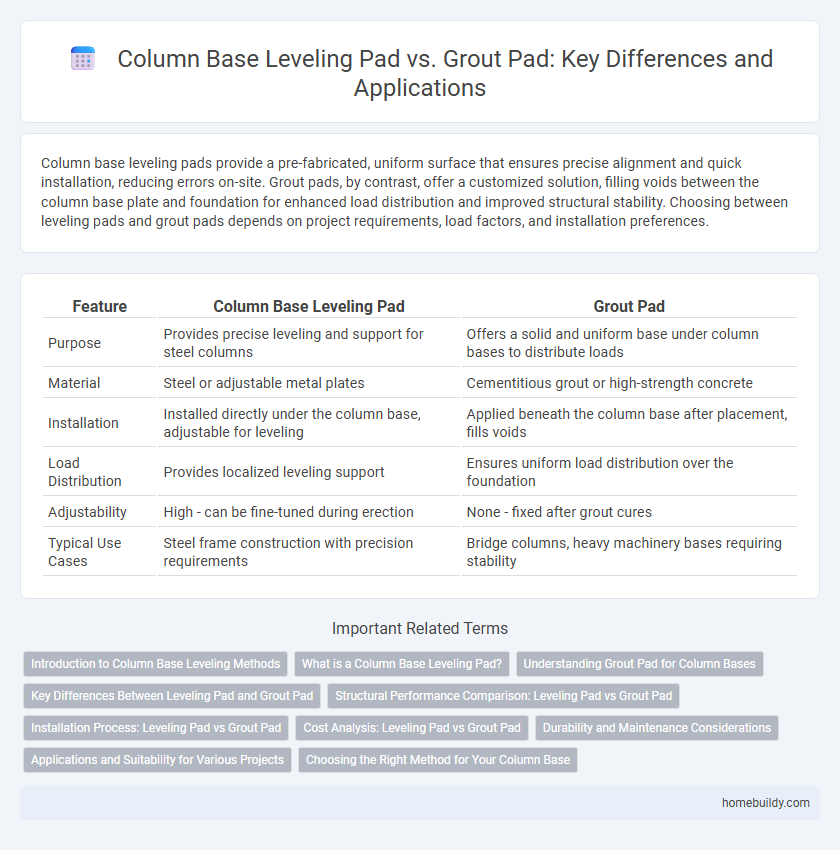Column base leveling pads provide a pre-fabricated, uniform surface that ensures precise alignment and quick installation, reducing errors on-site. Grout pads, by contrast, offer a customized solution, filling voids between the column base plate and foundation for enhanced load distribution and improved structural stability. Choosing between leveling pads and grout pads depends on project requirements, load factors, and installation preferences.
Table of Comparison
| Feature | Column Base Leveling Pad | Grout Pad |
|---|---|---|
| Purpose | Provides precise leveling and support for steel columns | Offers a solid and uniform base under column bases to distribute loads |
| Material | Steel or adjustable metal plates | Cementitious grout or high-strength concrete |
| Installation | Installed directly under the column base, adjustable for leveling | Applied beneath the column base after placement, fills voids |
| Load Distribution | Provides localized leveling support | Ensures uniform load distribution over the foundation |
| Adjustability | High - can be fine-tuned during erection | None - fixed after grout cures |
| Typical Use Cases | Steel frame construction with precision requirements | Bridge columns, heavy machinery bases requiring stability |
Introduction to Column Base Leveling Methods
Column base leveling methods primarily involve the use of leveling pads or grout pads to ensure proper alignment and load distribution. Leveling pads, typically made of metal or composite materials, provide a precise, adjustable platform for initial column positioning. Grout pads, composed of non-shrinkable grout, offer a durable and permanent solution by filling gaps between the column base and foundation, enhancing stability and load transfer.
What is a Column Base Leveling Pad?
A column base leveling pad is a precast concrete or steel element designed to provide a stable and level surface for column base plates during structural erection. It ensures accurate alignment and load distribution between the column and the foundation, minimizing the risk of uneven settlement or structural distortions. Unlike grout pads, leveling pads facilitate easier adjustments during installation without requiring extensive curing time.
Understanding Grout Pad for Column Bases
Grout pads provide a smooth, level surface between the column base and the concrete foundation, ensuring even load distribution and structural stability. Unlike leveling pads, grout pads fill voids and irregularities by hardening into a solid layer that bonds the base plate to the foundation, reducing stress concentrations. Proper application of non-shrink grout enhances durability and prevents corrosion beneath steel column bases, critical for maintaining long-term performance.
Key Differences Between Leveling Pad and Grout Pad
Leveling pads provide a stable and adjustable surface for column bases, ensuring precise alignment during installation, typically made from steel or rigid materials. Grout pads, composed of cementitious material, fill gaps between the column base and foundation, enhancing load transfer and preventing corrosion. Key differences include the leveling pad's role in adjustment and support versus the grout pad's purpose in sealing and durability improvement under structural loads.
Structural Performance Comparison: Leveling Pad vs Grout Pad
A column base leveling pad provides a stable, uniform surface to distribute structural loads and compensate for minor foundation irregularities, enhancing overall stability. In contrast, a grout pad offers superior load transfer efficiency by filling voids between the base plate and concrete, reducing stress concentrations and minimizing potential for uneven settlement. Structural performance favors grout pads in high-load or precision applications, while leveling pads are suitable for simpler, less critical installations.
Installation Process: Leveling Pad vs Grout Pad
Leveling pads simplify column base installation by providing a uniform, stable surface that requires minimal adjustments, using materials like compacted gravel or precast concrete. Grout pads demand more precise preparation, involving the application of non-shrink grout beneath the base plate to fill voids and ensure full bearing contact. The leveling pad installation is faster with less material sensitivity, while grout pads require skilled labor and curing time to achieve optimal support and alignment.
Cost Analysis: Leveling Pad vs Grout Pad
Column base leveling pads typically incur lower initial costs due to simpler materials and quicker installation compared to grout pads. Grout pads, while more expensive upfront, provide superior load distribution and long-term durability, potentially reducing maintenance expenses over time. Evaluating total lifecycle costs reveals that grout pads may offer better value in projects requiring enhanced stability and extended service life.
Durability and Maintenance Considerations
Column base leveling pads offer enhanced durability due to their ability to evenly distribute load and resist settling, reducing structural stress over time. Grout pads provide a solid, rigid foundation that minimizes movement but may require periodic inspection for cracks or voids that can compromise stability. Maintenance of leveling pads is generally simpler, focusing on surface cleaning, while grout pads often need more intensive monitoring and potential repair to maintain structural integrity.
Applications and Suitability for Various Projects
Column base leveling pads provide precise height adjustment and are ideal for projects requiring quick installation and realignment, such as steel structures and temporary frameworks. Grout pads offer superior load distribution and durability, making them suitable for permanent installations in heavy industrial, commercial buildings, and infrastructure projects. Selecting between leveling pads and grout pads depends on project demands for flexibility, load capacity, and environmental conditions.
Choosing the Right Method for Your Column Base
Choosing the right leveling pad for your column base depends on load requirements, site conditions, and installation precision. A grout pad provides excellent load distribution and durability for heavy columns and uneven surfaces, while a leveling pad offers quicker installation and cost efficiency for lighter loads and stable foundations. Evaluating structural demands and environmental factors ensures optimal stability and long-term performance of the column base.
column base leveling pad vs grout pad Infographic

 homebuildy.com
homebuildy.com